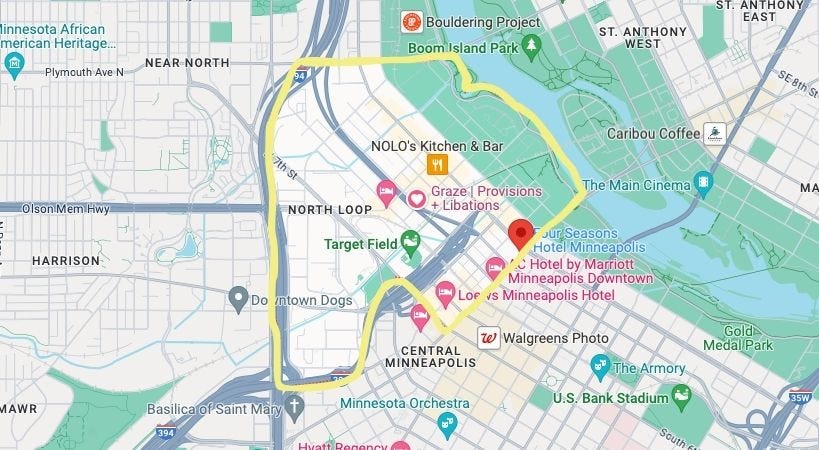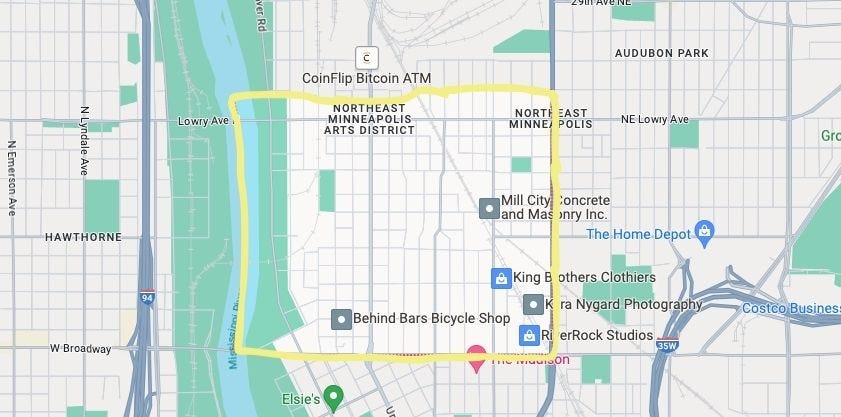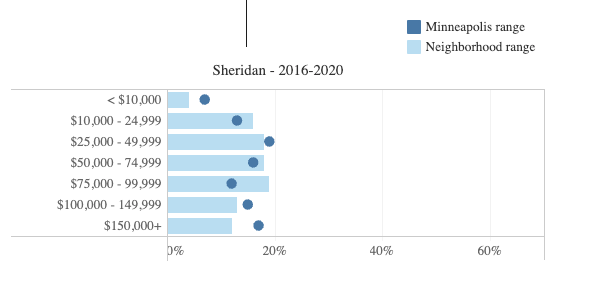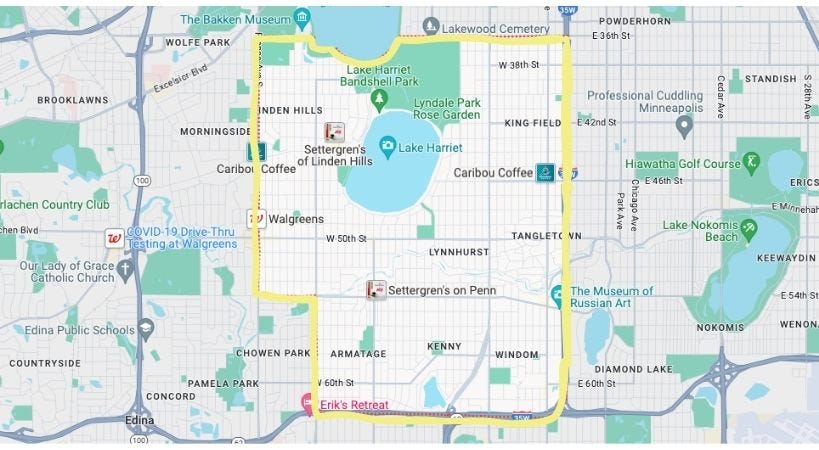Evaluating Your Target Market
Development 101
Alright.
Let’s do this.
We’re talking about ground-up real estate development here, and if you want a “bright build” or to build brightly/smartly— you know where I’m going with this — you need to know a few things.
(Oh. And a note: Today’s post is definitely best read in your browser!)
In an earlier post, I talked about walking your dreamland as a way of familiarizing yourself with the neighborhood(s) where you’re dreaming of building so that when the opportunity presents itself, you can act quickly. There’s a story Adam Piore tells about the famous developer William Zeckendorf walking around New York with, literally, a zoning map under his arm. When Zeckendorf found a viable development site - parking lots, abandoned structures, buildings that were smaller than current zoning laws allowed (he could build bigger!) he’d get out his highlighter and mark it down. This is how he found his sites and built his empire. This is how he found the site of the Mayflower Hotel (and several adjacent lots) and built 15 Central Park West, one of the most exclusive addresses in New York. As a side note, that entire development process is a story of how, sometimes, stubbornness wins over savvy in what resulted in the largest tenant relocation fee ever paid by a developer. Read the story. It’s worth it.
But before we settle on a dreamland, we have to figure out if it’s viable. And by viable, I mean we need to know if it’s growing, if the people there have good jobs with growing incomes, and if housing prices are stable or rising.
For our first Bright Build, we’re going to do it here in Minneapolis. Why? Shoot, because I live here. Further down the line, you all can weigh in on our next development (except for the six Bright Build subscribers who live in Australia and New Zealand. I’m not getting on that plane. Not yet :-)
Okay, so first question.
Is it growing?
We need a dreamland where we’re seeing population growth. Most markets/sub-markets have developers, and at some point, development gets ahead of growth. Developers stop for a while and wait for growth to catch up. It’s a stop-and-start cycle. But we always want to make sure that our population is growing. Why? There are a whole bunch of reasons:
Demand for housing: as the population grows, there’s a direct increase in the demand for housing.
Economic Activity: Population growth nearly always correlates to increased economic activity. Remember our discussion of “third places.” You need a neighborhood that can support the types of businesses that your future tenants want. What does Whole Foods require to build a store? Among other things, they want 200,000 people or more in a 20-minute drive time and a large number of college-educated residents.
Rental Yields: For those of you who want to “build and hold,” a growing population drives up rental demand.
Do people have good jobs with growing incomes?
Apart from the points above, growing incomes lead to two things, one obvious and one not so obvious. First, growing incomes lead to:
Stability, plain and simple: Growing incomes = stability = the ability to make longer-term commitments. Your success as a long-term real estate developer depends on your ability to carefully manage your operating expenses. Hidden within those expenses are vacancies and turnover. Provided you’ve matched your product and amenities with the market, tenants with rising incomes are more likely to stay put longer.
Community Investment: In my opinion, this is overlooked far too often by developers. When you build something from the ground up, you are planting your flag in that neighborhood and declaring your commitment to its well-being. BUT you need partners. You want to know that folks in your dreamland continue to climb the economic ladder so that they can turn around and reinvest some of that money back into their community. That’s how they become your partners, and that is no small thing.
Are housing prices rising?
The last thing you want to know is the direction of home prices. Over time, are they going up? Ideally, you want a high differential between home prices and rents. Regardless of how cheap the land is, you don’t want to own, say, a building where your two-bedroom apartments are $2,500/mo and a mortgage on a similarly sized house two blocks down is $2,600. People will usually choose the house.
Alright, so those are the three questions I ask BEFORE I’ve settled on my dreamland.
This is my research.
How do I answer these questions?
In a very, very non-sexy way. If you scratch the surface of every good development story, you’re going to find that it starts with math. And look, before you get anxious about the words “research” and “math,” let me tell you something. Research is just a fancy way of saying, “I know the right questions to ask.” And the math? It’s not hard. Anyone can do it. People just use the wrong numbers at the wrong time :-)
I can answer my three questions using publicly accessible databases that visualize information related to housing, population density, and income. This is what I use in Minneapolis. These databases are easily found online and leverage data from the US Census Bureau. It’s as simple as that.
Let’s start with three dreamlands/neighborhoods. I’m going to give you some information about each of them, and then, based on that information, we’re going to vote on where we might build.
Basic facts related to growth:
The current metro area population of Minneapolis in 2023 is 2,990,000, a 0.78% increase from 2022.
The metro area population of Minneapolis in 2022 was 2,967,000, a 0.71% increase from 2021.
The metro area population of Minneapolis in 2021 was 2,946,000, a 0.68% increase from 2020.
The metro area population of Minneapolis in 2020 was 2,926,000, a 0.65% increase from 2019.
First dreamland: The “North Loop”:
Located in Minneapolis's Warehouse District just northwest of downtown, The North Loop has evolved from its industrial roots in the late 19th and early 20th centuries into one of the city's most dynamic neighborhoods. Historically characterized by factories and warehouses, these structures have since been repurposed into lofts, boutiques, and high-end eateries. The neighborhood is home to Target Field, where the Minnesota Twins play. Its location offers easy access to major highways and public transit, making it both pedestrian and bike-friendly. Despite its rapid gentrification, challenges such as affordable housing persist.
Income ranges for the North Loop from 2016-2020 below:
Five-year housing prices for the zipcodes within the North Loop:
Second dreamland: The Northeast Minneapolis Arts District (comprised of Sheridan, Holland, Bottineau)
The Northeast Minneapolis Arts District, aka "Nordeast," is home to a dense concentration of working artists. The district is adorned with galleries, studios, and public art, making it a haven for art enthusiasts. One of its hallmark events, Art-A-Whirl, is the nation's largest open studio tour, offering a weekend brimming with art showcases and live music. The area's culinary scene flourishes with diverse restaurants and craft breweries. Despite its success, the district grapples with challenges like rising property values and gentrification.
Income ranges for the North East Minneapolis Arts District from 2016-2020 below:
Five-year housing prices for the zipcodes within the North East Minneapolis Arts District:
Third dreamland: Southwest Minneapolis (Linden Hills, Fulton, Kingfield, Lynnhurst)
Southwest Minneapolis is a scenic enclave in the city, characterized by its picturesque lakes such as Lake Harriet, Bde Maka Ska and Lake of the Isles, all set within the Chain of Lakes park system. This primarily residential area has a diverse range of architectural charm, from bungalows to grand homes nestled amidst tree-lined streets. Beyond its tranquil neighborhoods, vibrant pockets of commercial activity can be found, with places like Linden Hills offering boutique shops, eateries, and cafes. Notable attractions like the Bakken Museum and the Lake Harriet Band Shell enhance the area. With accessible bus routes and bike paths, the region fosters connectivity while evolving in its diversity.
Income ranges for Southwest Minneapolis from 2016-2020 below:
Five-year housing prices for the zipcodes within Southwest Minneapolis:
Okay…so
We have a state, we have a city, we have three submarkets. We asked three questions. Based on what you know at this moment in time, where would you look more closely to build? No wrong answers! Be brave :-) Just vote!
Next week, we’re going to talk about competitor analysis!
Looking for a community in your area? Cohorts is a small, vetted, private group of real estate operators that meet regularly, build relationships, and share resources to grow their real estate businesses together.





















Uhm. Did you just Master Class my Substack? THESE are the kind of deep-dive insights I need, Sean. Keep them coming!
Do you see “Harrison” and “Near North” as areas with high upside because of their proximity to North Loop?
Or are the infrastructure barriers going to limit the sprawl into these nearby neighborhoods and keep growth contained to the North Loop?